Integrated Runoff-Storm Surge Flood Hazard Mapping Associated with Tropical Cyclones in the Suburbs of La Paz, Baja California Sur, México
Abstract
:1. Introduction
2. Materials and Methods
2.1. Study Area
2.2. Methodology Conceptualization
2.3. La Palma River Mouth Flood Modeling
2.4. Storm Surge Scenarios
2.5. Runoff-Storm Surge Flood Hazard Map Integration
3. Results
3.1. Flooding in La Palma Creek River Mouth
3.2. Flooding by Storm Surge
3.3. Runoff-Storm Surge Flood Hazard Map
4. Discussion
4.1. Benefits and Limitations of the Model
4.2. Impact of Runoff-Storm Surge Hazard in the Study Area
5. Conclusions
Author Contributions
Funding
Institutional Review Board Statement
Informed Consent Statement
Data Availability Statement
Acknowledgments
Conflicts of Interest
References
- WBG (World Bank Group). Methods in Flood Hazard and Risk Assessment; International Bank for Reconstruction and Development: Washington, DC, USA, 2016; 28p. [Google Scholar]
- United Nations Office for Disaster Risk Reduction (UNISDR). Economic Losses, Porverty& Disasters 1998–2017; Centre for Research on the Epidemiology of Disasters (CRED): Brussels, Belgium, 2017; 31p. [Google Scholar]
- Romero-Monteiro, L.; Innocente-Dos Santos, C.; Kobiyama, M.; Weber-Corseuil, C.; Borges-Chaffe, P.L. Effects of return periods on flood hazard mapping: An analysis of the UFSC Campus Basin, Florianópolis city, Brazil. Braz. J. Water Resour. 2021, 26, 9. [Google Scholar] [CrossRef]
- Ionita, M.; Nagavciuc, V. Extreme floods in the Eastern Part of Europe: Large-Scale Drivers and Associated Impacts. Water 2021, 13, 1122. [Google Scholar] [CrossRef]
- Darabi, H.; Haghighi, A.T.; Mohamadi, M.A.; Rashidpour, M.; Ziegler, A.D.; Hekmatzadeh, A.A.; Klove, B. Urban flood risk mapping using data-driven geospatial techniques for a flood-prone case area in Iran. Hydrol. Res. 2019, 51, 127–142. [Google Scholar] [CrossRef] [Green Version]
- Singh, A.; Dawson, D.; Trigg, M.; Wright, N. A review of modelling methodologies for flood source area (FSA) identification. Nat. Hazards 2021, 107, 1047–1068. [Google Scholar] [CrossRef]
- O’Donnell, E.; Thorne, C.; Ahilan, S.; Arthur, S.; Birkinshaw, S.; Butler, D.; Dawson, D.; Everett, G.; Fenner, R.; Glenis, V.; et al. The blue-green path to urban flood resilience. Blue-Green Syst. 2020, 2, 28–45. [Google Scholar] [CrossRef] [Green Version]
- Doocy, S.; Dick, A.; Daniels, A.; Kirsch, T.D. The human impact of tropical cyclones: A historical review of events 1980–2009 and systematic literature review. PLoS Curr. 2013, 5, 5. [Google Scholar] [CrossRef] [PubMed]
- Maspataud, A.; Ruz, M.-H.; Vanhée, S. Potential impacts of extreme storm surges on a low-lying densely populated coastline: The case of Dunkirk area, Northern France. Nat. Hazards 2013, 66, 1327–1343. [Google Scholar] [CrossRef]
- Liu, Q.; Ruan, C.; Guo, J.; Li, J.; Lian, X.; Yin, Z.; Fu, D.; Zhong, S. Storm Surge Hazard Assessment of the Levee of a Rapidly Developing City-Based on LiDAR and Numerical Models. Remote Sens. 2020, 12, 3723. [Google Scholar] [CrossRef]
- Bertin, X. Storm Surges and coastal flooding: Status and challenges. Houille Blanche 2016, 102, 64–70. [Google Scholar] [CrossRef]
- Sheng, P.Y.; Lapentina, A.; Ma, G. The reduction of storm surge by vegetation canopies:Three dimensional simulations. Geophys. Res. Lett. 2012, 39, 20. [Google Scholar] [CrossRef] [Green Version]
- Ellis, J.T.; Sherman, D.J. Chapter 1—Perspectives on coastal and marine Hazards and Disasters. In Coastal and Marine Hazards, Risks, and Disasters; Elsevier: Amsterdam, The Netherlands, 2015; pp. 1–13. [Google Scholar] [CrossRef]
- Knutson, T.R. Tropical Cyclones and hurricanes. In Encyclopedia of Atmospheric Sciences; Elsevier: Amsterdam, The Netherlands, 2015; pp. 65–76. [Google Scholar] [CrossRef]
- Aranud-Fassetta, G.; Astrade, L.; Bardou, E.; Corbonnois, J.; Delahaye, D.; Fort, M.; Gautier, E.; Jacob, N.; Peiry, J.; Piégay, H.; et al. Fluvial geomorphology and flood-risk management. Géomorphol. Relief Process. Environ. 2009, 2, 109–128. [Google Scholar] [CrossRef] [Green Version]
- Cai, S.; Fan, J.; Yang, W. Flooding Risk Assessment and Analysis Based on GIS and the TFN-AHP Method: A Case Study of Chongqing, China. Atmosphere 2021, 12, 623. [Google Scholar] [CrossRef]
- Khattak, M.S.; Anwar, F.; Saeed, T.U.; Sharif, M.; Sheraz, K.; Ahmed, A. Floodplain Mapping Using HEC-RAS and ArcGIS: A Case Study of Kabul River. Arab. J. Sci. Eng. 2016, 41, 1375–1390. [Google Scholar] [CrossRef]
- Abdessamed, D.; Abderrazak, B. Coupling HEC-RAS and HEC-HMS in rainfall–runoff modeling and evaluating floodplain inundation maps in arid environments: Case study of Ain Sefra city, Ksour Mountain. SW, Algeria. Environ. Earth Sci. 2019, 78, 586. [Google Scholar] [CrossRef]
- Islam, R.; Lee, C.-Y.; Mandli, K.T.; Takagi, H. A new tropical cyclone surge index incorporating the effects of coastal geometry, bathymetry and storm information. Sci. Rep. 2021, 11, 16747. [Google Scholar] [CrossRef]
- Romero-Vadillo, E. Modelación de Numérica de Ondas de Tormenta en la Bahía de La Paz y Cabo San Lucas, Baja California Sur. Ph.D. Thesis, Centro Interdisciplinario de Ciencias Marinas del Instituto Politécnico Nacional, La Paz, Mexico, 2003. [Google Scholar]
- Tate, C.A.; Frazier, T.G. A GIS Methodology to Assess Exposure of Coastal Infraestructure to Storm Surge & Sea-Level Rise: A CaseStudy of Sarasota County, Florida. J. Geogr. Nat. Disasters 2013, 3, 1–12. [Google Scholar] [CrossRef] [Green Version]
- Johnston, J.; Cassalho, F.; Miesse, T.; Ferreira, C.M. Projecting the effects of land subsidence and sea level rise on storm surge flooding in Coastal North Carolina. Sci. Rep. 2021, 11, 21679. [Google Scholar] [CrossRef]
- Veeramony, J.; Condon, A.; Van-Ormont, M. Forecasting Storm Surge and Inundation: Model Validation. Weather Forecast. 2017, 32, 2047–2063. [Google Scholar] [CrossRef]
- Machineni, N.; Sinha, V.S.P.; Singh, P.; Reddy, N.T. The impact of distributed land use information in hydrodynamic model application in storm surge inundation. Estuarine Coast. Shelf Sci. 2019, 231, 106466. [Google Scholar] [CrossRef]
- Secretaría de Desarrollo Social (SEDESOL). Atlas de Riesgos y Peligros Naturales del Municipio de La Paz, BCS; Soluciona Arquitectura y Construcción S.A. de C.V.: Hermosillo, Mexico, 2012; 271p. [Google Scholar]
- Atlas Nacional de Riesgos. Available online: http://atlasnacionalderiesgos.gob.mx/archivo/visor-capas.html (accessed on 9 September 2021).
- Romero Vadillo, E.; Romero Vadillo, I.G. Estimación del riesgo en las viviendas de Baja California Sur ante el impacto de ciclones tropicales. Teor. Prax. 2016, 12, 50–73. [Google Scholar] [CrossRef]
- Muria-Avila, D. Investigación y Desarrollo. In El Huracán Odile y sus Efectos en la Infraestructura del sur de la Península de Baja California; Instituto de Ingeniería de la UNAM: Ciudad de México, Mexico, 2015; pp. 1–3. [Google Scholar]
- Romero-Vadillo, E.; y Romero-Vadillo, I.G. Ciclones Tropicales: Tendencias y potencial de afectación en Baja California Sur. In Baja California Sur ante el Cambio Climático: Vulnerabilidad, Adaptación y Mitigación (PEAC-BCS); UABCS-SEMARNAT-CIBNOR-CICESE-INECC-IPN-CICIMAR: La Paz, Mexico, 2013; 43p. [Google Scholar]
- Censo de Vivienda INEGI 2010. Available online: https://www.inegi.org.mx/programas/ccpv/2010/#Tabulados (accessed on 3 September 2021).
- Censo de Vivienda INEGI 2020. Available online: https://www.inegi.org.mx/programas/ccpv/2020/#Tabulados (accessed on 3 September 2021).
- Rodríguez-Trasviña, J. Modelación de Análisis por Inundaciones para Diferentes Periodos de Retorno en el Arroyo La Palma, en la Ciudad de La Paz, Baja California Sur, México. Bachelor’s Thesis, Universidad Autónoma de Baja California Sur, La Paz, Mexico, June 2021. [Google Scholar]
- Ramos-Velázquez, R. Características de la Deformación en las Rocas Cristalinas Cretácicas de la Región E-SE de la Ciudad de La Paz, B.C.S., México. Master’s Thesis, Centro de Investigación Científica y de Educación Superior de Ensenada, Ensenada, Mexico, 1998. [Google Scholar]
- Ramos-Velázquez, E.; Iriondo, A.; Cota-Lau, H.G.; Díaz-Gutiérrez, J.J. Evolución tectónica de la suite intrusiva de Las Cruces, BCS: Control temporal a partir de geocronología U-Pb en circones. In Proceedings of Reunión Anual de la Unión Geofísica Mexicana A.C.; UGM: Puerto Vallarta, Mexico, 2013. [Google Scholar]
- Puy y Alquiza, M.D.J. Caracterización de Facies, Ambientes Sedimentarios y Procesos de Depósito de la Sucesión Volcanosedimentaria El Coyote, Baja California Sur, México. Ph.D. Thesis, Instituto Politécnico Nacional, Centro Interdisciplinario de Ciencias Marinas, Departamento de Oceanología, La Paz, Mexico, 2006. [Google Scholar]
- Umhoefer, P.J.; Dorsey, R.J.; Willsey, S.; Mayer, L.; Renne, P. Stratigraphy and geochronology of the Comondú Group near Loreto, Baja California Sur, Mexico. Sedim. Geol. 2001, 144, 125–147. [Google Scholar] [CrossRef]
- Hausback, B.P. Geology of the Baja California Peninsula: Pacific Section. In Cenozoic Volcanic and Tectonic Evolution of Baja California Sur, México, in Frizzell, 1st ed.; Society of Economic Paleontologists and Mineralogists: Los Angeles, CA, USA, 1984; pp. 219–236. [Google Scholar]
- Aranda Gómez, J.J.; Pérez Venzor, J.A. Estratigrafía del complejo cristalino de la región de Todos Santos, estado de Baja California Sur, Universidad Nacional Autónoma de México. Inst. Geol. Rev. 1989, 8, 149–170. [Google Scholar]
- Geographical and Statistical Information of Mexico (INEGI). Available online: https://www.inegi.org.mx/ (accessed on 4 May 2021).
- Climatologic Database Servicio Meteorológico Nacional. Available online: https://smn.conagua.gob.mx/es/climatologia/informacion-climatologica/informacion-estadistica-climatologica (accessed on 3 September 2021).
- Cruz-Falcón, A.; Vázquez-González, R.; Ramírez-Hernández, J.; Nava-Sánchez, E.; Troyo-Diéguez, E. Rainfall and recharge in the basin of La Paz, B.C.S, México. Univ. Cienc. 2011, 27, 251–263. [Google Scholar]
- Wurl, J.; Martínez-García, C.N.; Imaz-Lamadrid, M.A. Flood hazard assessmentof La Purísima Oasis in Baja California Sur, México. Investig. Geogr. Bol. Inst. Geogr. UNAM 2015, 87, 76–87. [Google Scholar]
- Imaz-Lamadrid, M.A.; Wurl, J.; Ramos-Velázquez, E. Future of Coastal Lagoons in Arid Zones under Climate Change and Anthropogenic Pressure. A Case Study from San Jose Lagoon, Mexico. Resources 2019, 8, 57. [Google Scholar] [CrossRef] [Green Version]
- Imaz-Lamadrid, M.A.; Wurl, J.; Arizpe-Covarrubias, O.; Romero-Vadillo, E. Deterioration of oases subject to climate change and coastal development: The case of Todos Santos Oasis, Baja California Sur, Mexico. Groundwater for Sust. Groundw. Sustain. Dev. 2020, 11, 100401. [Google Scholar] [CrossRef]
- Marín-Monroy, E.A.; Trejo-Hernández, V.; Romero-Vadillo, R.; Ivanova-Boncheva, A. Vulnerability and risk factors due to tropical cyclones in coastal cities of Baja California Sur, Mexico. Climate 2020, 8, 144. [Google Scholar] [CrossRef]
- Thakur, B.; Parajuli, R.; Kalra, A.; Ahmad, S.; Gupta, R. Coupling HEC-RAS and HEC-HMS in precipitation runoff modeling and evaluating flood plain inundation map. In Proceedings of the World Environmental and Water Resources Congress, Sacramento, CA, USA, 21–25 May 2017; pp. 240–251. [Google Scholar]
- Natarajan, S.; Radhakrishnan, N. An integrated hydrologic and hydraulic flood modeling study for a medium-sized ungauged urban catchment area: A case study of Tiruchirappalli City Using HEC-HMS and HEC-RAS. J. Inst. Eng. (India) Ser. A. 2020, 101, 381–398. [Google Scholar] [CrossRef]
- QGIS.org. QGIS Geographic Information System. Open Source Geospatial Foundation Project. 2021. Available online: http://qgis.org (accessed on 13 November 2021).
- Flumen Institute. Design Storm Calculation through the Alternate Blocks Methods. 2021. Available online: https://www.flumen.upc.edu/en/documents/software/bloques.rar/view (accessed on 24 October 2021).
- Chow, V.T.; Maidment, D.R.; Mays, L.W. Applied Hydrology; McGraw-Hill: New York, NY, USA, 1988; p. 572. [Google Scholar]
- HEC-HMS Technical Reference Manual. Available online: https://www.hec.usace.army.mil/confluence/hmsdocs/hmstrm (accessed on 16 November 2021).
- Cronshey, R. Urban Hydrology for Small Watersheds; United States Agriculture Department (USDA): Washington, DC, USA, 1986. [Google Scholar]
- Kirpich, Z.P. Time of concentration of small agricultural watersheds. Civil. Eng. 1940, 10, 362. [Google Scholar]
- Hydrologic Engineering Center. Hec-Ras River Analysis System; Hydrologic Engineering Center: Davis, CA, USA, 2020; 705p. [Google Scholar]
- Meza-Padilla, R.; Appendini, C.M.; Pedrozo-Acuña, A. Hurricane induced waves and storm surge modeling for the Mexican coast. Ocean Dyn. 2015, 65, 1199–1211. [Google Scholar] [CrossRef]
- Emanuel, K.; Rotunno, R. Self-Stratification of Tropical Cyclone Outflow. Part I: Implications for Storm Structure. J. Atmos. Sci. 2011, 68, 2236–2249. [Google Scholar] [CrossRef]
- Kirtman, B.; Power, S.B.; Adedoyin, J.A.; Boer, G.J.; Bojariu, R.; Camilloni, I.; Doblas-Reyes, F.J.; Fiore, A.M.; Kimoto, M.; Meehl, G.A.; et al. Near-term Climate Change: Projections and Predictability. In Climate Change 2013: The Physical Science Basis. Contribution of Working Group I to the Fifth Assessment Report of the Intergovernmental Panel on Climate Change; Stocker, T.F., Qin, D., Plattner, G.-K., Tignor, M., Allen, S.K., Boschung, J., Nauels, A., Xia, Y., Bex, V., Midgley, P.M., Eds.; Cambridge University Press: Cambridge, UK; New York, NY, USA, 2013; pp. 1137–1215. Available online: https://www.ipcc.ch/pdf/assessment-report/ar5/wg1/WG1AR5_Chapter11_FINAL.pdf (accessed on 29 October 2020).
- Vermeer, M.; Rahmstorf, S. Global sea level linked to global temperature. Proc. Natl. Acad. Sci. USA 2009, 106, 21527–21532. [Google Scholar] [CrossRef] [PubMed] [Green Version]
- Farfán, L.M.; Alfaro, E.J.; Cavazon, T. Characteristics of tropical cyclones making landfall on the Pacific Coast of Mexico: 1970–2010. Atmosfera 2013, 26, 163–182. [Google Scholar] [CrossRef] [Green Version]
- National Hurricane Center’s Tropical Cyclone Reports. Available online: https://www.nhc.noaa.gov/data/tcr/index.php?season=2021&basin=epac (accessed on 26 November 2021).
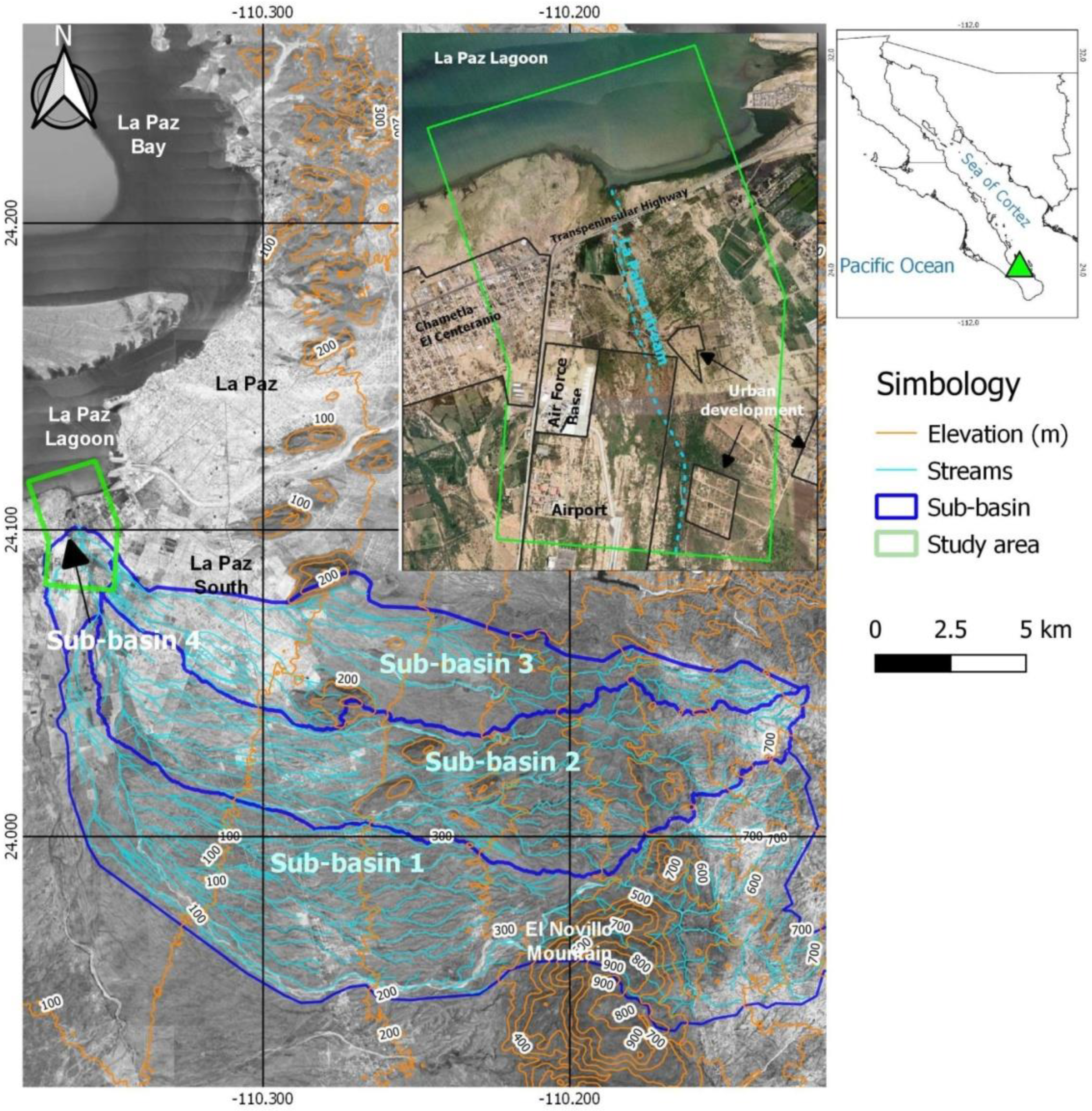
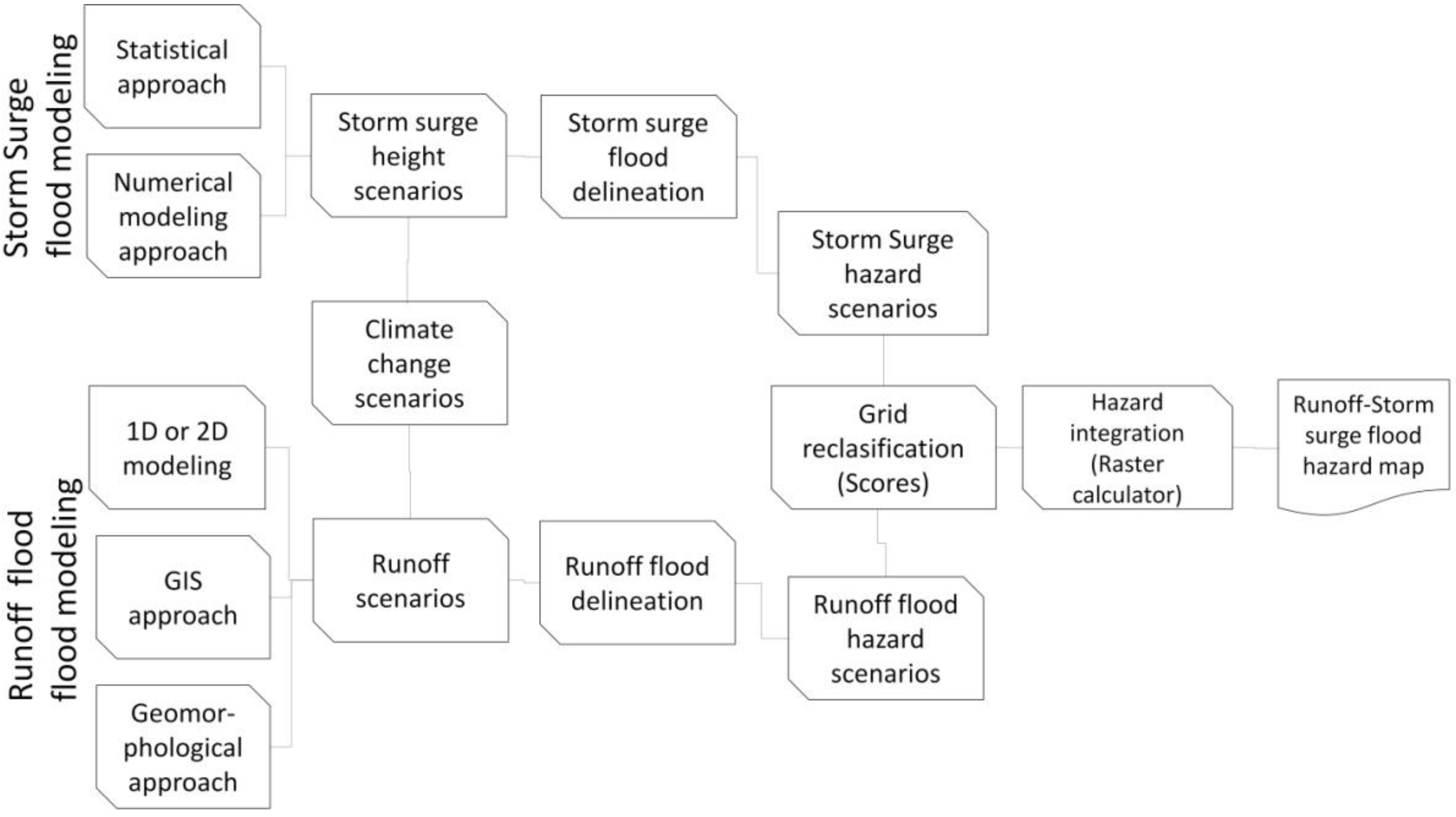
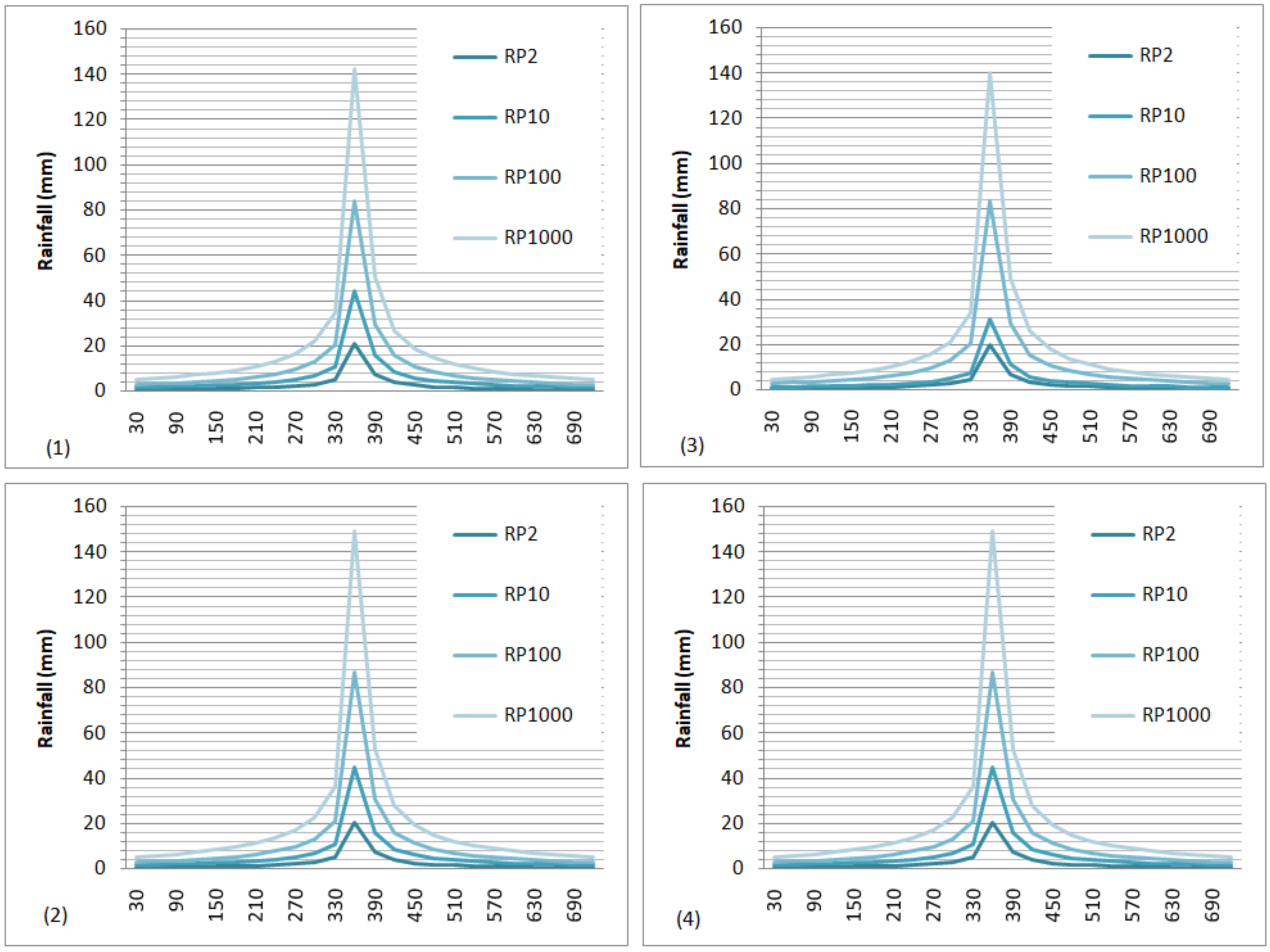
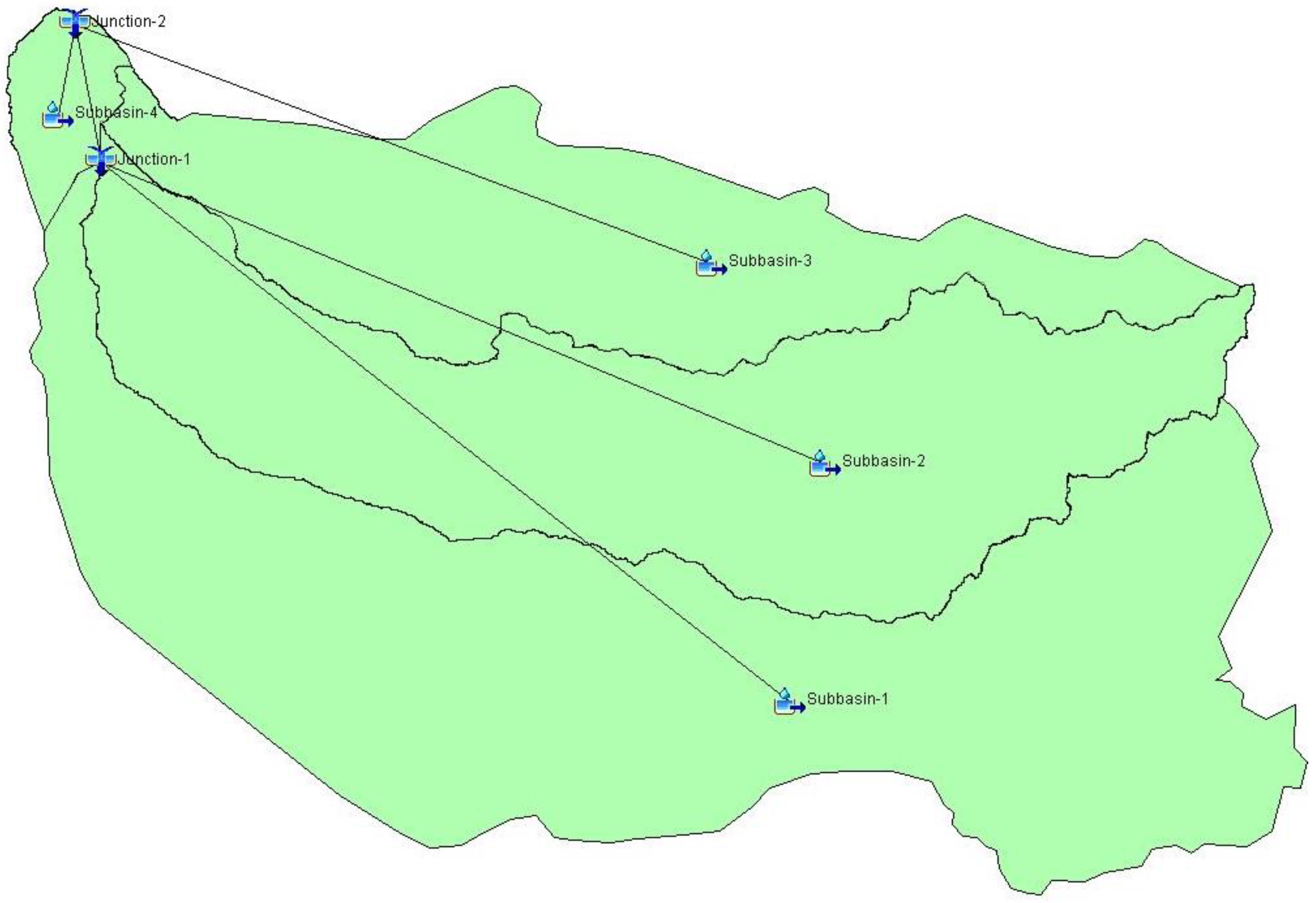
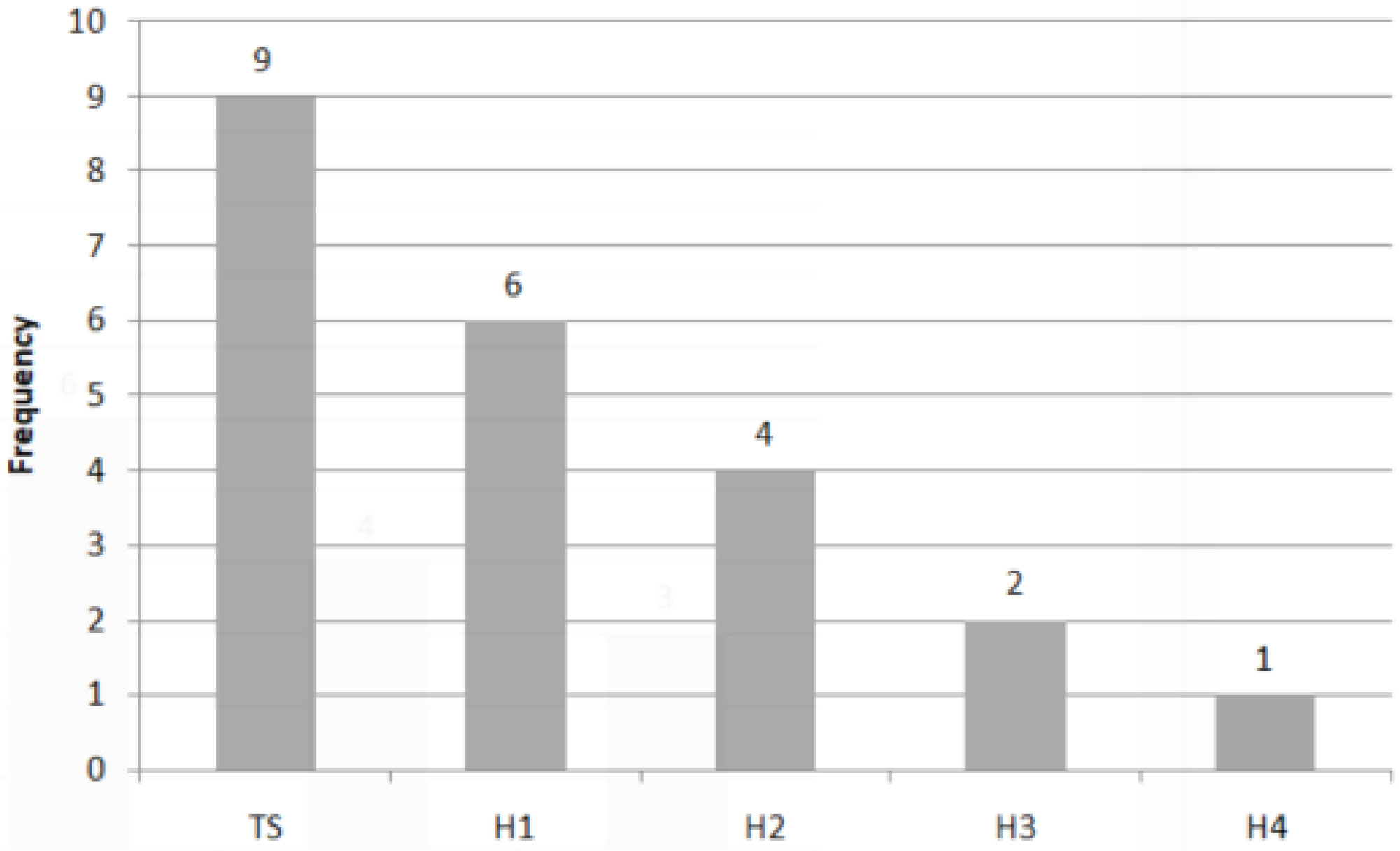

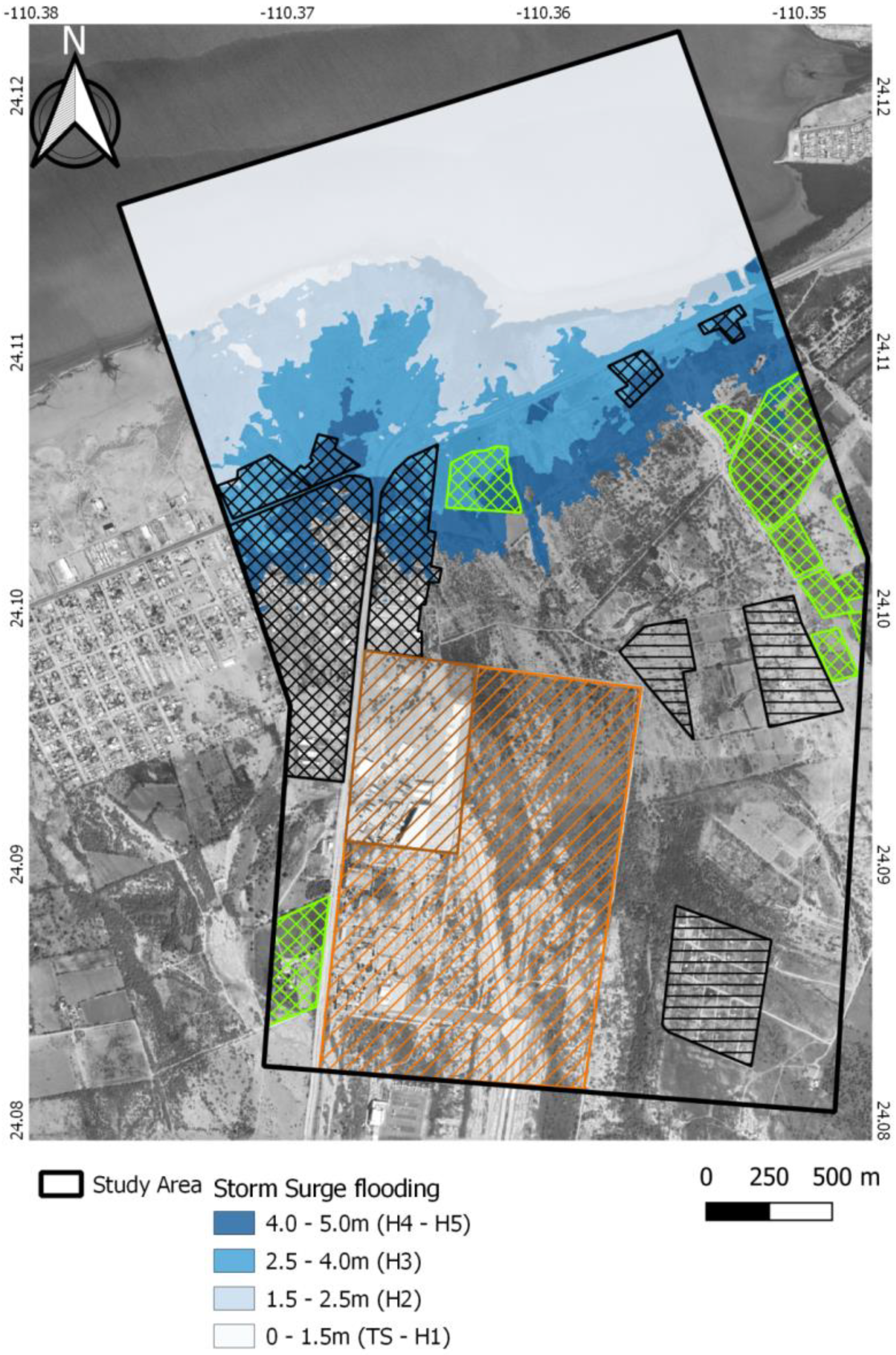
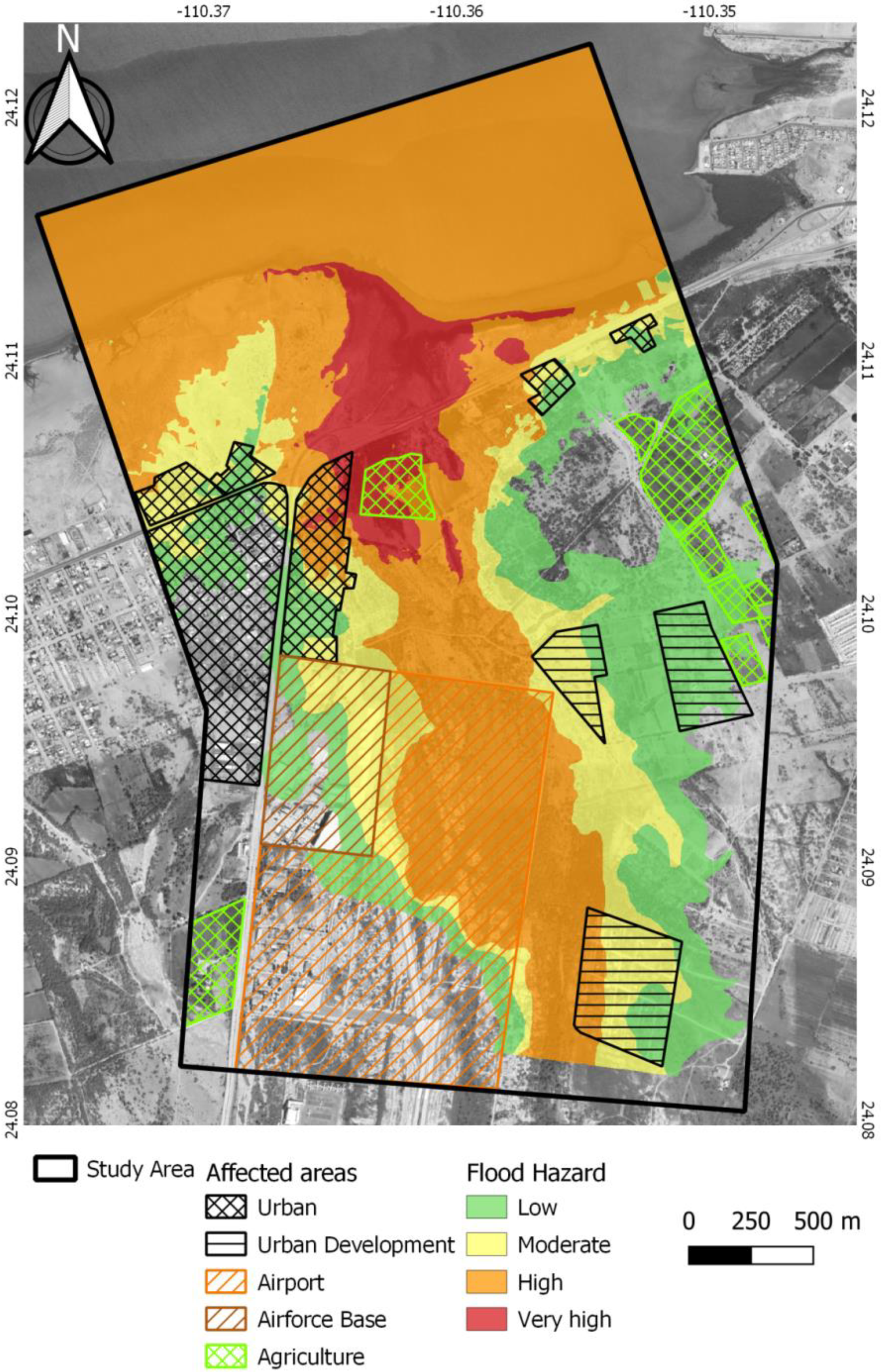
| Weather Station ID | Years of Records | Min (mm/24 h) | Max (mm/24 h) | Average (mm/24 h) | Standard Deviation |
|---|---|---|---|---|---|
| 3110 | 1978–2017 | 18.0 | 173.0 | 57.5 | 42.4 |
| 3167 | 1982–2017 | 30.0 | 237.0 | 82.0 | 50.7 |
| 3077 | 1961–2017 | 16.0 | 240.0 | 65.7 | 42.1 |
| 3015 | 1962–2017 | 6.0 | 493.0 | 51.9 | 68.7 |
| 3036 | 1944–2017 | 20.0 | 360.0 | 84.5 | 64.6 |
| 3011 | 1965–2017 | 24.0 | 347.5 | 98.8 | 77.8 |
| 3023 | 1953–2017 | 34.5 | 220.0 | 76.8 | 38.6 |
| 3058 | 1945–2017 | 36.0 | 221.0 | 83.5 | 44.3 |
| 3074 | 1940–2017 | 22.9 | 137.0 | 56.4 | 27.4 |
| 3104 | 1977–2017 | 23.0 | 359.0 | 97.2 | 79.8 |
| Weather Station ID | RP2 (mm/24 h) | RP10 (mm/24 h) | RP100 (mm/24 h) | RP1000 (mm/24 h) |
|---|---|---|---|---|
| 3110 | 44.9 | 108.4 | 219.5 | 377.8 |
| 3167 | 68.53 | 144.9 | 273.9 | 452.1 |
| 3077 | 55.0 | 117.1 | 213.8 | 563.3 |
| 3015 | 34.7 | 108.0 | 278.8 | 563.3 |
| 3036 | 66.3 | 158.8 | 318.3 | 542.9 |
| 3011 | 76.9 | 193.4 | 383.8 | 625.3 |
| 3023 | 66.9 | 124.2 | 218.1 | 345.0 |
| 3058 | 71.9 | 138.2 | 248.3 | 399.0 |
| 3074 | 49.8 | 91.2 | 153.1 | 226.6 |
| 3104 | 73.4 | 192.5 | 416.5 | 768.0 |
| Intensity of Tropical Cyclone | Probability of Occurrence | Storm Surge Scenario |
|---|---|---|
| TS-H1 | 0.670 | 1.5 m |
| H2 | 0.180 | 2.5 m |
| H3 | 0.090 | 4.0 m |
| H4-H5 | 0.045 | 5.0 m |
| La Palma Model Results | Runoff Hazard Score | Storm Surge Scenarios | Storm Surge Hazard Score | Runoff-Storm Surge Flood Map | Runoff-Storm Surge Flood Hazard |
|---|---|---|---|---|---|
| TR2 | 4 | 1.5 m | 4 | 8–4 | Very High |
| TR10 | 3 | 2.5 m | 3 | 4–2 | High |
| TR100 | 2 | 4.0 m | 2 | 2–1 | Moderate |
| TR1000 | 1 | 5.0 m | 1 | 1–0.1 | Low |
Publisher’s Note: MDPI stays neutral with regard to jurisdictional claims in published maps and institutional affiliations. |
© 2021 by the authors. Licensee MDPI, Basel, Switzerland. This article is an open access article distributed under the terms and conditions of the Creative Commons Attribution (CC BY) license (https://creativecommons.org/licenses/by/4.0/).
Share and Cite
Imaz-Lamadrid, M.A.; Wurl, J.; Ramos-Velázquez, E.; Rodríguez-Trasviña, J. Integrated Runoff-Storm Surge Flood Hazard Mapping Associated with Tropical Cyclones in the Suburbs of La Paz, Baja California Sur, México. GeoHazards 2022, 3, 1-15. https://doi.org/10.3390/geohazards3010001
Imaz-Lamadrid MA, Wurl J, Ramos-Velázquez E, Rodríguez-Trasviña J. Integrated Runoff-Storm Surge Flood Hazard Mapping Associated with Tropical Cyclones in the Suburbs of La Paz, Baja California Sur, México. GeoHazards. 2022; 3(1):1-15. https://doi.org/10.3390/geohazards3010001
Chicago/Turabian StyleImaz-Lamadrid, Miguel Angel, Jobst Wurl, Ernesto Ramos-Velázquez, and Jaqueline Rodríguez-Trasviña. 2022. "Integrated Runoff-Storm Surge Flood Hazard Mapping Associated with Tropical Cyclones in the Suburbs of La Paz, Baja California Sur, México" GeoHazards 3, no. 1: 1-15. https://doi.org/10.3390/geohazards3010001
APA StyleImaz-Lamadrid, M. A., Wurl, J., Ramos-Velázquez, E., & Rodríguez-Trasviña, J. (2022). Integrated Runoff-Storm Surge Flood Hazard Mapping Associated with Tropical Cyclones in the Suburbs of La Paz, Baja California Sur, México. GeoHazards, 3(1), 1-15. https://doi.org/10.3390/geohazards3010001






